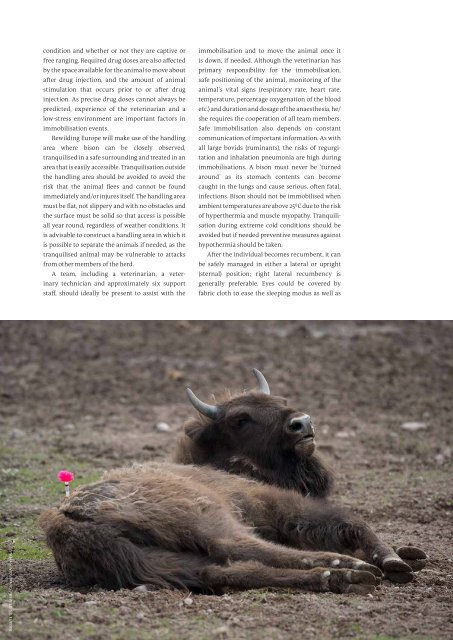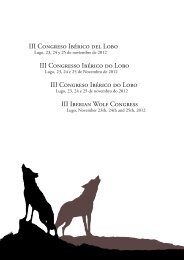Bison-Rewilding-Plan-2014
Bison-Rewilding-Plan-2014
Bison-Rewilding-Plan-2014
- No tags were found...
Create successful ePaper yourself
Turn your PDF publications into a flip-book with our unique Google optimized e-Paper software.
condition and whether or not they are captive orfree ranging. Required drug doses are also affectedby the space available for the animal to move aboutafter drug injection, and the amount of animalstimulation that occurs prior to or after druginjection. As precise drug doses cannot always bepredicted, experience of the veterinarian and alow-stress environment are important factors inimmobilisation events.<strong>Rewilding</strong> Europe will make use of the handlingarea where bison can be closely observed,tranquilised in a safe surrounding and treated in anarea that is easily accessible. Tranquilisation outsidethe handling area should be avoided to avoid therisk that the animal flees and cannot be foundimmediately and/or injures itself. The handling areamust be flat, not slippery and with no obstacles andthe surface must be solid so that access is possibleall year round, regardless of weather conditions. Itis advisable to construct a handling area in which itis possible to separate the animals if needed, as thetranquilised animal may be vulnerable to attacksfrom other members of the herd.A team, including a veterinarian, a veterinarytechnician and approximately six supportstaff, should ideally be present to assist with theimmobilisation and to move the animal once itis down, if needed. Although the veterinarian hasprimary responsibility for the immobilisation,safe positioning of the animal, monitoring of theanimal’s vital signs (respiratory rate, heart rate,temperature, percentage oxygenation of the bloodetc.) and duration and dosage of the anaesthesia, he/she requires the cooperation of all team members.Safe immobilisation also depends on constantcommunication of important information. As withall large bovids (ruminants), the risks of regurgitationand inhalation pneumonia are high duringimmobilisations. A bison must never be ‘turnedaround’ as its stomach contents can becomecaught in the lungs and cause serious, often fatal,infections. <strong>Bison</strong> should not be immobilised whenambient temperatures are above 25ºC due to the riskof hyperthermia and muscle myopathy. Tranquilisationduring extreme cold conditions should beavoided but if needed preventive measures againsthypothermia should be taken.After the individual becomes recumbent, it canbe safely managed in either a lateral or upright(sternal) position; right lateral recumbency isgenerally preferable. Eyes could be covered byfabric cloth to ease the sleeping modus as well asSTAFFAN WIDSTRAND / REWILDING EUROPE55



